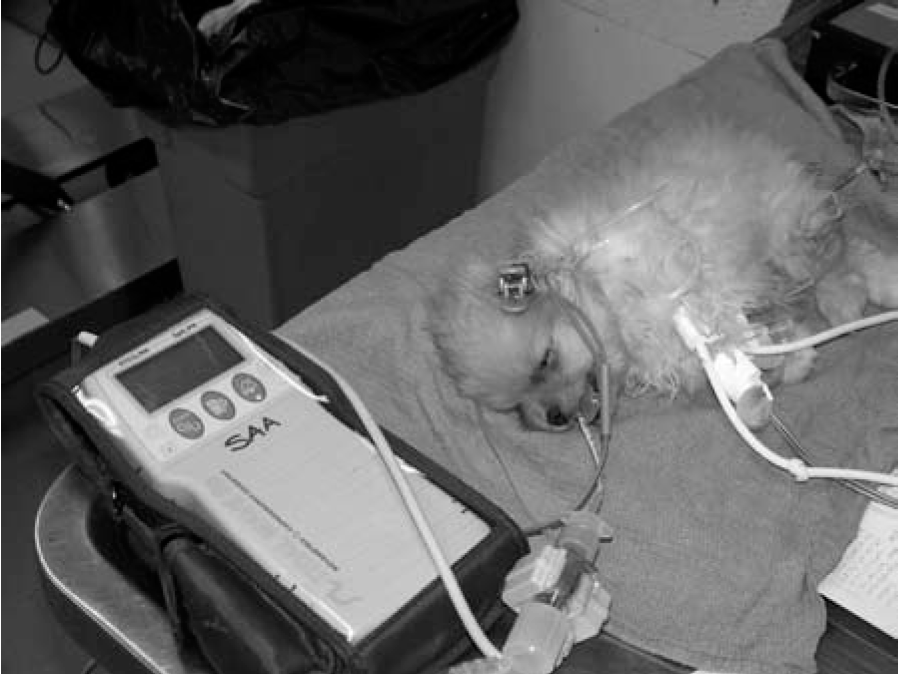normal end tidal co2 dog
This non-invasive monitor can give valuable information about cardiac output perfusion and ventilation. It is the measurement of CO2 at the completion of exhalation and roughly correlates to the CO2 present in arterial blood.

Learn More With This Respiratory Article By Melissa Marshall
Because of the slow response of the infra-red carbon dioxide analyser satisfactory recordings of end-tidal carbon dioxide could not be.

. The end-tidal level of carbon dioxide is generally less but is reflective of carbon dioxide in arterial blood and can serve as an indirect noninvasive method of assessing the adequacy ventilation. Anaesthesia of the dog Veterinary Anaesthesia Eleventh Edition 2014 Chapter 15 Pages 405-498. Total pressure of a gas is the sum of the partial pressures of the gas Expired CO2 measured PetCO2 mmHg in waveform Percentage Normal Levels PaO2 85-100mmHg PaCO2 35-45mmHg Percentage vs.
The end-tidal carbon dioxide tension PetCO2 measured after a single large tidal-volume breath 15 mlkg body weight was compared to simultaneous measurements of PaCO2 in 6 dogs with normal lungs who were receiving high-frequency jet ventilation HFJV. Normal arterial blood pressure values for dogs and cats are indicated in Table 111. The measurement of end-tidal carbon dioxide ETCO 2 allows the continuous monitoring of the adequacy of ventilation and circulation in the anaesthetised patientIt measures inspired and expired carbon dioxide CO 2 throughout the whole respiratory cycle using infrared spectroscopyETCO 2 can be of value in the assessment of ventilation metabolism and of a.
Capnography is the measurement and evaluation of the levels of CO2 in a patients exhaled breath or the end-title CO2 ETCO2. There was an excellent linear correlation b. Systole represents cardiac contraction and diastole occurs during cardiac filling.
Since problems with lungs are not common and gas exchange between alveoli and the blood is swift and effective. The arterial to end-tidal PCO2 difference PaCO2-PECO2 was measured in five anaesthetized dogs during controlled ventilation at 025 Hz 15 bpm and during high frequency jet ventilation at 1 3 and 5 Hz. Carbon dioxide during ventilation.
78 Nitrogen 21 Oxygen 1 CO2 and other gases Exhaled gases. A more complete picture of carbon dioxide transfer can be obtained from a capnogram similar to an ECG tracing. End-tidal carbon dioxide ETco 2 monitoring provides valuable information about CO 2 production and clearance ventilation.
Capnography waveforms etCO2 and breathing patterns. Common narrow plateaus seen during. This is an important component of anesthesia because it helps the anesthetist evaluate the patients respiratory rate and also the quality of the respirations breaths.
Capnography can be used to measure end-tidal CO 2. Join us in this hour and learn about monitoring the patient undergoing anesthesia interpretation of end tidal carbon dioxide CO2 values and appropriate interventions for patients with abnormal values. 11172009 4 Measuring End Tidal CO2 Daltons Law.
Simultaneous comparison of heart rate ECG or stethoscope with pulse rate palpation or blood pressure monitor allows the anesthetist to pick up some dysrhythmias. In this study the aim was to review the applications of end-tidal carbon dioxide ETCO2 monitoring in emergency department multiple databases were comprehensively searched with combination of following keywords. Heart rate can be monitored from an ECG from a stethoscope esophageal stethoscope pulse oximeter or blood pressure monitor.
Capnograph is an indispensable tool for monitoring metabolic and respiratory function. The mean arterial pressure MAP is determined by the following equation. Examples of some common capnograms are.
End-tidal carbon dioxide monitoring ETCO2 has clinical uses far beyond solely determining hypo- or hyperventilation. Pulse pressure is a result of the difference between the systolic and diastolic pressures. Therefore better interpretation of the.
ETCO2 emergency department monitoring and critical. Also called capnometry or capnography this noninvasive technique provides a breath-by-breath analysis and a continuous recording of ventilatory status. Normal end tidal co2 dog Monday April 25 2022 Edit The measurement of end-tidal carbon dioxide ETCO 2 allows the continuous monitoring of the adequacy of ventilation and circulation in the anaesthetised patientIt measures inspired and expired carbon dioxide CO 2 throughout the whole respiratory cycle using infrared spectroscopyETCO 2 can be.
In fact its commonly called the ventilation vital sign. MmHg Relate to the air we breath. Variants of normal ETCO2 tracings from normal anesthetized animals.
Most anesthetics are respiratory depressants and end-tidal CO2 allows early detection of respiratory impairment so appropriate intervention can occur before the problem becomes life threatening. In conditions of normal breathing 6 Lmin 12 breathsmin 500 ml for tidal volume etCO 2 is very close to alveolar CO2.

Pdf Capnography In Dogs Semantic Scholar

E Learning Basics Of Capnography Youtube
Riding The Wave Of Capnography Understanding Etco2 Vetbloom Blog

Pdf Capnography In Dogs Semantic Scholar
Riding The Wave Of Capnography Understanding Etco2 Vetbloom Blog

Vetgrad 10 Minute Top Up The Website For Vets

Learn More With This Respiratory Article By Melissa Marshall

Pdf Capnography In Dogs Semantic Scholar

Learn More With This Respiratory Article By Melissa Marshall

Pdf Capnography In Dogs Semantic Scholar

Capnography In Veterinary Medicine Chapter 28 Capnography

Learn More With This Respiratory Article By Melissa Marshall
Did You Know Hypercapnia Is Synonymous With Hypoventilation

Learn More With This Respiratory Article By Melissa Marshall

Learn More With This Respiratory Article By Melissa Marshall

Learn More With This Respiratory Article By Melissa Marshall
